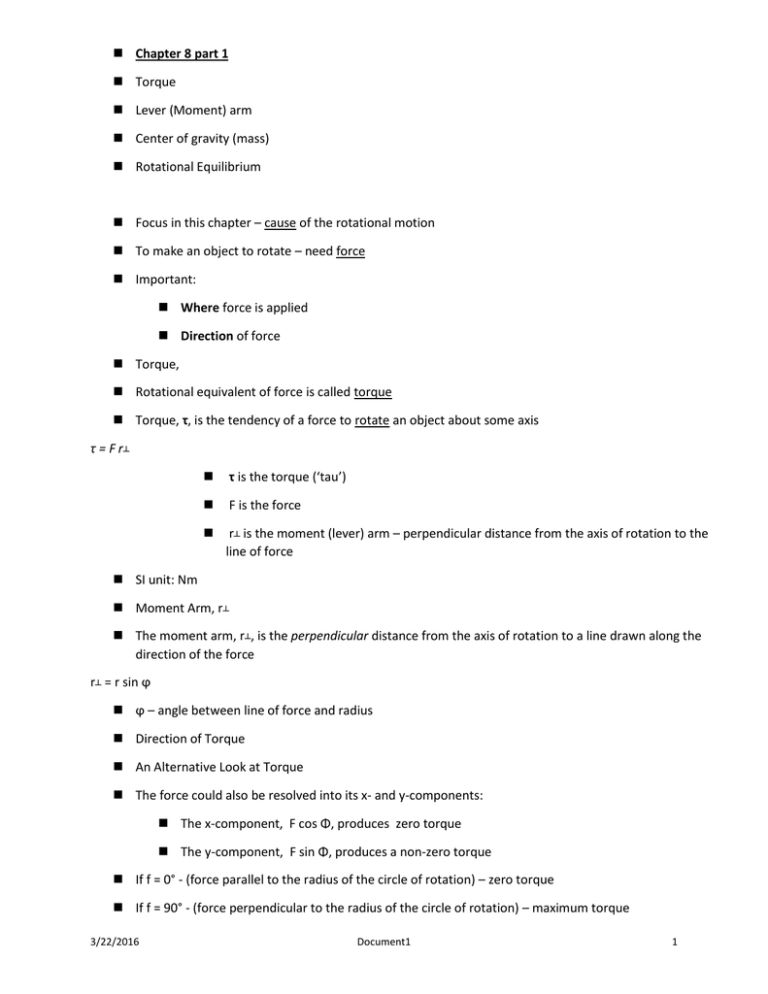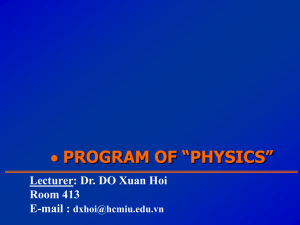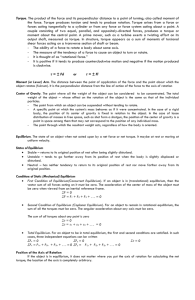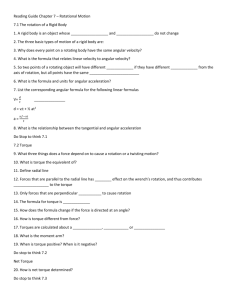Chapter 8 part 1 Torque Lever (Moment) arm Center of gravity (mass
advertisement

Chapter 8 part 1 Torque Lever (Moment) arm Center of gravity (mass) Rotational Equilibrium Focus in this chapter – cause of the rotational motion To make an object to rotate – need force Important: Where force is applied Direction of force Torque, Rotational equivalent of force is called torque Torque, τ, is the tendency of a force to rotate an object about some axis τ = F r┴ τ is the torque (‘tau’) F is the force r┴ is the moment (lever) arm – perpendicular distance from the axis of rotation to the line of force SI unit: Nm Moment Arm, r┴ The moment arm, r┴, is the perpendicular distance from the axis of rotation to a line drawn along the direction of the force r┴ = r sin ϕ ϕ – angle between line of force and radius Direction of Torque An Alternative Look at Torque The force could also be resolved into its x- and y-components: The x-component, F cos Φ, produces zero torque The y-component, F sin Φ, produces a non-zero torque If f = 0° - (force parallel to the radius of the circle of rotation) – zero torque If f = 90° - (force perpendicular to the radius of the circle of rotation) – maximum torque 3/22/2016 Document1 1 From the components of the force or from the lever arm, τ = F r sinϕ F is the force r is the distance from force to axis of rotation θ is the angle between F and r ex 1 To open a door a force F is applied at a distance r from the axis of rotation. If the minimum torque required to open the door is 3.1 Nm, what force must be applied if (a) r = 0.94 m, (b) r = 0.35 m? ex 2 What is the magnitude of the torque exerted by each of the force on the door? Net Torque The net torque is the sum of all the torques produced by all the forces Remember to account for the direction of the tendency for rotation: Counterclockwise torques are positive Clockwise torques are negative ex 3 Find the net torque exerted on the crate if its width is 1.0 m. Assume an axis of rotation through the center of the crate. Center of Gravity The force of gravity acting on an object must be considered In finding the torque produced by the force of gravity, all of the weight of the object can be considered to be concentrated at one point Calculating the Center of Gravity The object is divided up into a large number of very small particles of weight (mg) Each particle will have a set of coordinates indicating its location (x,y) The torque produced by each particle about the axis of rotation is equal to its weight times its lever arm The point of application of the single force , whose magnitude is equal to the weight of the object, and whose effect on the rotation is the same as all the individual particles is called the center of gravity of the object Coordinates of the Center of Gravity The coordinates of the center of gravity can be found from the sum of the torques acting on the individual particles being set equal to the torque produced by the weight of the object Center of Gravity of a Uniform Object The center of gravity of a homogenous, symmetric body must lie on the axis of symmetry. 3/22/2016 Document1 2 Often, the center of gravity of such an object is the geometric center of the object. Experimentally Determining the Center of Gravity The wrench is hung freely from two different pivots The intersection of the lines indicates the center of gravity A rigid object can be balanced by a single force equal in magnitude to its weight as long as the force is acting upward through the object’s center of gravity Conditions of Equilibrium First Condition of Equilibrium The net external force must be zero This is a statement of translational equilibrium This is a necessary, but not sufficient, condition to ensure that an object is in complete mechanical equilibrium To ensure mechanical equilibrium, you need to ensure rotational equilibrium as well as translational The Second Condition of Equilibrium: The net external torque must be zero Mechanical Equilibrium In this case, the First Condition of Equilibrium is satisfied The Second Condition is not satisfied Both forces would produce clockwise rotations Axis of Rotation If the object is in equilibrium, it does not matter where you put the axis of rotation for calculating the net torque Often the nature of the problem will suggest a convenient location for the axis When solving a problem, you must specify an axis of rotation Once you have chosen an axis, you must maintain that choice consistently throughout the problem Notes About Equilibrium A zero net torque does not mean the absence of rotational motion An object that rotates at uniform angular velocity can be under the influence of a zero net torque This is analogous to the translational situation where a zero net force does not mean the object is not in motion Solving Equilibrium Problems Draw a diagram of the system 3/22/2016 Document1 3 Isolate the object being analyzed and draw a free body diagram showing all the external forces acting on the object For systems containing more than one object, draw a separate free body diagram for each object Establish convenient coordinate axes for each object. Apply the First Condition of Equilibrium Choose a convenient rotational axis for calculating the net torque on the object. Apply the Second Condition of Equilibrium Solve the resulting simultaneous equations for all of the unknowns ex4 A child of mass m is supported on a light plank of length L by his parents, who exert forces of F1 and F2. Find the forces required to keep the plank in static equilibrium. Use the right end of the plank as the axis of rotation. ex5 A 5.00m long diving board of negligible mass is supported by two pillars. One pillar is at the left end of the diving board, the other is d = 1.50m away. Find the forces exerted by the pillars when a 90.0kg diver stands at the far end of the board. ex6 A cat walks along a uniform plank that is 4.00m long and has mass of M=7.00kg. The plank is supported by two sawhorses, one 0.440m from the left end of the board and the other 1.50m from its right end. When the cat reaches the right end, the plank just begins to tip. What is the mass m of the cat? Example of a FBD Isolate the object to be analyzed Draw the free body diagram for that object Include all the external forces acting on the object ex7 Find the upward force exerted by the bicepts (F) on the forearm and the downward force exerted by the humerus (R) on the forearm, acting at the joint. Neglect the weight of the arm. Example of a FBD The free body diagram includes the directions of the forces The weights act through the centers of gravity of their objects ex8 If a 600. N person stands 1.50 m from the wall, find the tension in the cable (T) and the force exerted by the wall on the beam (R). ex9 A uniform 10.m long, 50.N ladder rests against a smooth vertical wall. If the ladder is just on the verge of slipping when it makes a 50° angle with the ground, find the coefficient of static friction between the ladder and the ground. 3/22/2016 Document1 4 ex (20.) A hungry 700. N bear walks out on a beam in an attempt to retrieve some “goodies” hanging at the end. The beam is uniform, weighs 200. N, and is 6.00 m long; the goodies weigh 80.0 N. (a) Draw a free-body diagram for the beam. (b) When the bear is at x = 1.00 m, find the tension in the wire and the components of the reaction force at the hinge. (c) If the wire can withstand a maximum tension of 900. N, what is the maximum distance the bear can walk before the wire breaks? ex (25.) An 8.00 m, 200. N uniform ladder rests against a smooth wall. The coefficient of static friction between the ladder and the ground is 0.600, and the ladder makes a 50.0° angle with the ground. How far up the ladder can an 800. N person climb before the ladder begins to slip? ex (28.) One end of a uniform 4.0-m-long rod of weight w is supported by a cable. The other end rests against the wall, where it is held by friction. The coefficient of static friction between the wall and the rod is μs = 0.50. Determine the minimum distance x from point A at which an additional weight w (same as the weight of the rod) can be hung without causing the rod to slip at point A. 3/22/2016 Document1 5







